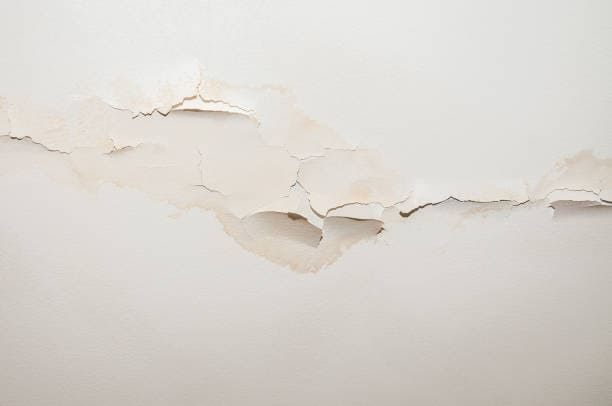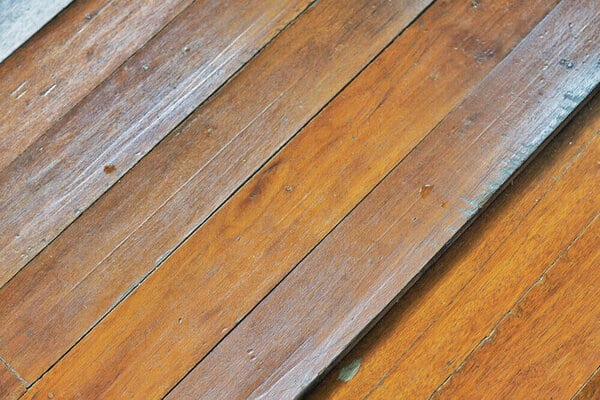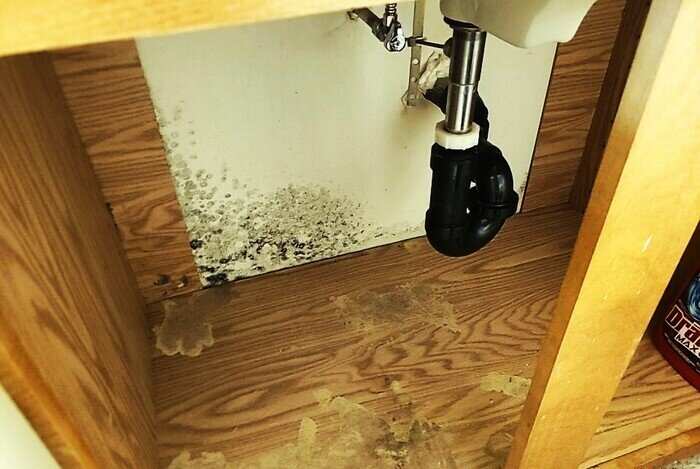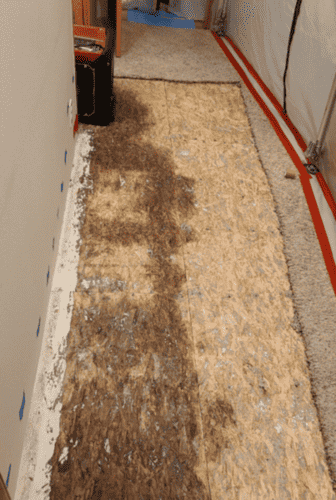House hunting can be an incredibly exciting experience! But it’s not exciting to worry about whether you might accidentally buy a home that has previous, current, or future water damage problems. We want to equip you with the knowledge to avoid this outcome at all costs! We’re Cleaner Guys, a professional water damage restoration company with more than 20 years of experience dealing with water damage. In this article, we’re going to share our insider knowledge with you on how to tell if a house you’re looking at has water damage, so that you don’t fall into this trap!
Table of Contents
- Top 10 Signs of Water Damage in For-Sale Houses
- Don’t Skip the Home Inspection! (Why It’s So Important)
- What to Do If You Find Signs of Water Damage in a House For Sale
- Signs of Potential Future Water Damage
- More Resources
Top 10 Signs – How to Tell if a House You’re Looking at Has Water Damage
The possible signs of water damage are many, but they all follow the same patterns. Excess water anywhere causes swelling, staining, sagging, rotting, and mold. Here are the top 10 most common signs of such water damage in houses. These are extremely important to look for when walking through house showings, because you don’t want to be stuck with old or current water damage as a new homeowner.
1: Stains, bubbling, cracking, or peeling in the walls or ceilings
Soft, swollen, cracked, peeling, or stained drywall is a sure sign of water damage. Water staining on drywall looks brownish, sometimes grayish, and a bit like a coffee stain (see image below).

2: Swollen or warped wood, like trim, door or window casing
If you find that any doors are hard to open or close because the door casing seems to be swollen or warped, this is another possible sign of water damage. To be sure it’s water damage, it is best to be able to combine this sign with others from this list. Sometimes doors that are hard to open or close can just be because the house is old.

3: Mold or mold smells
Mold is an almost guaranteed sign of current or previous water damage. Mold only grows where there is excess moisture. Sometimes, mold will grow where you can’t see it, like inside wall cavities, so you should also pay attention to any mold smells. Mold odor can be described as musty, damp, earthy, and pungent.

4: Water stains, mold, or rusty plumbing under sinks
Checking inside the cupboards under each sink is absolutely crucial when inspecting a home for the first time. They’re one of the most common places for a leak to go unnoticed for a long time, which leads to water damage and mold growth.

5: Wet carpet, especially corners and edges
Wet carpet is a sure sign of water where it shouldn’t be. Carpet that is wet near the edges and corners of the room almost certainly indicates water damage inside the walls.

6: Damaged exterior
Holes in the roof, missing shingles, gaps in siding caulking, and damaged or rotted wood are all ways water can penetrate into a home. If you see any of these kinds of exterior damage, then if water is not already inside the house, it will be someday.

7: Standing water in the crawlspace
Standing water in a crawlspace can be a sign of water damage in the house. Sometimes, it is just groundwater that ran into the crawlspace, but it should be investigated as a potential water damage sign anyway.

8: Wet or moldy insulation in the crawlspace
Wet or moldy insulation in the crawlspace is almost always a sign of some kind of water intrusion, either from below or from above.

9: A very old or rusty water heater, especially with drip marks on it
Old water heaters are much more likely to cause water damage, either in the past or in the future. Signs that a water heater has already leaked or burst before can include rust, obvious pipe connection repair or replacement, and old dried drip marks on the tank.

10: Dripping or gushing sounds
Hearing dripping or gushing water coming from somewhere in the house is an obvious sign of water intrusion somewhere. The source is often a leaking or burst pipe inside a wall, so try to pinpoint the spot of the water intrusion by sound and by looking for water damage signs on the walls.
Don’t Skip the Home Inspection! (Why It’s So Important)
I’ve been working in water damage restoration for years, and just a few months ago, I bought a house. I knew all the signs to look for, including every one of the ones in the list above. I saw no signs of water damage.
Then we paid for a professional home inspection. The inspector used an infrared thermal scanner, and she found major water damage inside the walls behind the master bathroom shower. If I had relied on this list alone, and skipped a professional inspection, even though I’m a professional in water damage, we might have bought the home without knowing there was major water damage behind the shower. Who knows how long it would have festered and grown mold there until we noticed it! It probably would have given us mold sickness.
This is why getting professional home inspections is so important. You simply cannot detect what an infrared thermal scanner can.
This list of water damage signs to look for is meant to help warn you away from seriously water-damaged houses before you ever get to the inspection stage. It is not meant to replace the necessity of a professional home inspection with thermal imaging.
What to Do If You Find Signs of Water Damage in a House For Sale
If you find signs of water damage in a house that you’re interested in, the most important thing to do is talk to your realtor about it. They are experts at negotiating damage repair with sellers, which may be what you want if you are still interested in the house. Many sellers are willing to negotiate repairing the damage for you.
When a home inspection revealed water damage around the shower in the house we were looking at, we told our realtor about it, and she negotiated for the seller to have the damage repaired on their dime. We ended up buying the house!
Not all sellers will be willing to pay for the damage repair. However, you should still discuss your options with your realtor.
Signs of Potential Future Water Damage
When you’re trying to figure out how to tell if a house you’re looking at has water damage, signs of potential future water damage should also be considered. While old or current water damage would require negotiating repairs with the seller or leaving the house behind, things that could cause future water damage will be on your head entirely, if you buy the home. Signs of potential future water damage include:
- Very old appliances, such as dishwashers, water heaters, refrigerators, and washing machines, pose a great risk of breaking down and causing water damage if you don’t replace them when you buy the home.
- A damaged exterior, such as damaged siding, roof, or windows and doors is just inviting water intrusion. If the house has any of these, either walk away from it or negotiate repairs. If water hasn’t gotten into the house already, it will if those things aren’t repaired.
- Water collecting around windows, such as condensation or pooling on the windowsill, can indicate improperly sealed windows. This can allow water intrusion later down the line, if it hasn’t happened already.
- Gutter spouts that empty closer than 1.5 feet from the house can allow water from the gutters to settle right next to your house, encouraging water intrusion into the basement or crawlspace.
- Copper plumbing is outdated, but many older homes still have it. Copper pipes are much more likely to crack or burst if they freeze, unlike modern plastic plumbing. Be wary of this fact when buying a home with copper plumbing. If you follow our guide to keeping pipes from freezing in the winter, you should be fine.
More Resources
We have a vast archive of important and useful information on water damage, mold, fire damage, and more on our blog. Check it out here, or jump straight to the next most relevant article to you using the links below!
How to check for mold in a house you’re looking at buying ➜
Top 10 signs of mold hidden inside the walls ➜
Can you paint over mold? The professional answer ➜
If you’re looking at houses in Western Washington State, and you end up needing to find someone for water damage restoration or mold removal, consider Cleaner Guys as a high-quality, well-trusted option. We’re proud to boast award-winning customer service, lower prices than others, and top-notch workmanship! Contact us today through the menu at the top of your screen.

Disclaimer: This article is for informational purposes only. No part of this article is medical or legal advice, and may not be used as such. For all serious medical matters, consult your doctor. For all serious legal matters, consult your legal advisor. This article contains Cleaner Guys’ experience and opinions only.
We hope you enjoyed our article on how to tell if a house you’re looking at has water damage! Leave a comment with any praise or questions you may have!


